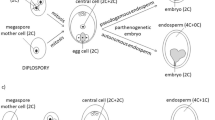Abstract
RAPD markers have been obtained in Cladosporium fulvum, in order to establish a genetic map based on mitotic recombination in this imperfect fungus. Segregation analysis has provided molecular evidence of a high degree of recombination during the parasexual cycle, and of the ploidy level of the parasexual progeny. A molecular study of 49 RAPDs obtained showed that, with only one exception, all RAPD markers studied represent repetitive DNA. This situation precludes the direct use of these markers to either initiate chromosome walking to a gene of interest or for the assignment of linkage groups to electrophoretically-separated chromosomes. A simple reamplification test has been applied which permitted the quick discrimination between single-copy and repetitive DNA species, without the need for Southern analysis. Additionally, evidence is shown for the presence of single-stranded DNA species in the amplification products, and that these may be present in addition to their double-stranded counterparts. The reamplification test can also identify these DNA species, avoiding misinterpretation of polymorphic bands.
Similar content being viewed by others
References
Ackerveken GFJM van den, van Kan JAL, de Wit PJGM (1992) Molecular analysis of the avirulence gene avr9 of the fungal tomato pathogen Cladosporium fulvum fully supports the gene-for-gene hypothesis. Plant J 2:359–366
Anderson PA, Tyler BM, Pryor A (1992) Genome complexity of the maize rust fungus, Puccinia sorghi. Exp Mycol 16:302–307
Arnau J, Oliver RP (1993) Inheritance and alteration of transforming DNA during an induced parasexual cycle in the imperfect fungus Cladosporium fulvum. Curr Genet 23:508–511
Botstein D, White RL, Skolnick MII, Davis RW (1980) Construction of a genetic linkage map in man using restriction fragment length polymorphisms. Am J Hum Genet 32:314–331
Feinberg A, Vogelstein B (1983) A technique for radiolabelling DNA restriction endonuclease fragments to high specific activity. Anal Biochem 132:6–13
Maniatis T, Fritsch EF, Sambrook J (1982) Molecular cloning: a laboratory manual. Cold Spring Harbor, New York
McHale MT, Roberts IN, Noble SM, Beaumont C, Whitehead MP, Seth D, Oliver RP (1992) CfT-1: an LTR-retrotransposon in Cladosporium fulvum, a fungal pathogen of tomato. Mol Gen Genet 233:337–347
Oliver RP, Farman ML, Talbot NJ, McHale MT (1991) Molecular biology of fungal plant pathogenicity. In: Peberdy JF, Caten CE, Ogden JE, Bennett JW (eds) Applied molecular genetics of fungi. Cambridge University Press, Cambridge, pp 170–182
Oliver RP, Horskins A, Arnau J, Coleman MJ (1992) Molecular analyses of the tomato pathogen Cladosporium fulvum. 1st European Conf Fungal Genet. Nottingham, UK, Abstract Book, p 2.39
Paran I, Michelmore RW (1993) Development of reliable PCR-based markers linked to downy mildew resistance genes in lettuce. Theor Appl Genet 85:985–993
Talbot NJ (1990) Genetic and genomic analysis in Cladosporium fulvum (syn. Fulvia fulva). PhD thesis, University of East Anglia
Talbot NJ, Coddington A, Roberts IN, Oliver RP (1988) Diploid construction by protoplast fusion in Fulvia fulva (syn. Cladosporium fulvum): genetic analysis of an imperfect fungal plant pathogen. Curr Genet 14:567–572
Welsh J, McClelland M (1990) Fingerprinting genomes using PCR with arbitrary primers. Nucleic Acids Res 18:7213–7218
Williams JGK, Kubelik AR, Livak KJ, Rafalski JA, Tingey SV (1990) DNA polymorphisms amplified by arbitrary primers are useful as genetic markers. Nucleic Acids Res 18:6531–6535
Williams JGK, Kubelik AR, Rafalski JA, Tingey SV (1991) Genetic analysis with RAPD markers. In: Lasure L, Bennett JW (eds) More gene manipulation in fungi. Academic Press, London, pp 431–439
Author information
Authors and Affiliations
Additional information
Communicated by K. Wolf
Rights and permissions
About this article
Cite this article
Arnau, J., Housego, A.P. & Oliver, R.P. The use of RAPD markers in the genetic analysis of the plant pathogenic fungus Cladosporium fulvum . Curr Genet 25, 438–444 (1994). https://doi.org/10.1007/BF00351783
Received:
Accepted:
Issue Date:
DOI: https://doi.org/10.1007/BF00351783




